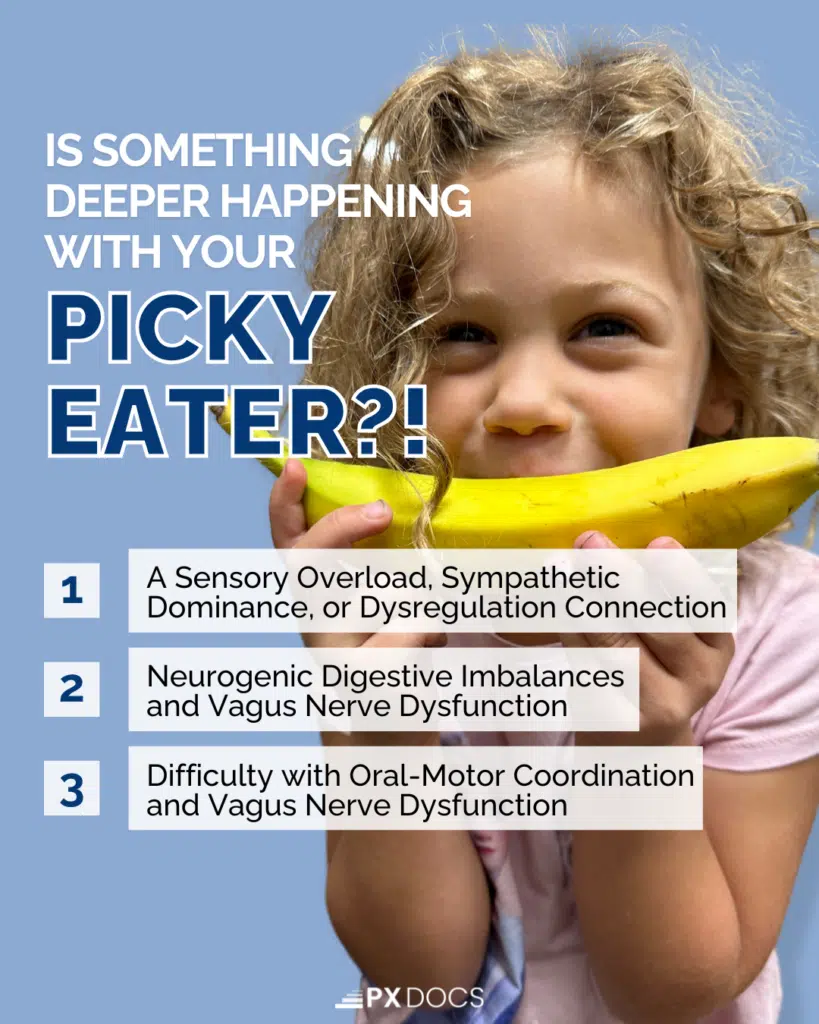As parents, we’ve all faced it—the dinnertime battle where getting your kid to eat anything but a specific, narrow selection of foods. While some level of picky eating is common in childhood, for some families, it becomes a persistent, frustrating, and stressful issue. If you’re one of those families and you feel like you’ve tried everything without success, don’t worry—you’re not alone.
In 2017, a meta-analysis of multiple studies found that 22% of children are picky eaters. A separate study reported that 40% of picky eaters remain picky for two years or longer.
At PX Docs, we take a different approach to understanding picky eating. Instead of focusing only on food preferences or behavioral habits, we look at what’s happening beneath the surface—within the nervous system.
Often, picky eating can be linked to neurological imbalances caused by subluxations, a type of stress or interference within the neurospinal system that disrupts nervous system function. Let’s dive into the three key subluxation-related reasons why your child might be an extremely picky eater and explore actionable solutions to address them.

1. Sensory Overload, Sympathetic Dominance, and Dysregulation
Does your child gag at the sight of broccoli or refuse to touch certain textures of food? This reaction could stem from sensory overload. Subluxations, particularly in the upper cervical and brainstem regions, create stress on the central and autonomic nervous system, leading to sensory processing challenges. When the nervous system is overstimulated and unable to regulate sensory input effectively, textures, tastes, and smells can become overwhelming.
For a picky eater, this sensory overload makes mealtime feel like a battlefield. Kid-friendly foods that should be neutral or enjoyable instead trigger discomfort, avoidance, or even meltdowns. It’s not about being stubborn—it’s about the nervous system being unable to handle the sensory input from certain foods.
Underneath all of this is a neurological state known as sympathetic dominance or overdrive. When a child’s nervous system is stuck in this subluxated, sympathetic dominant state, it can actually change the child’s brain and body’s cravings for food. Being stuck on “fight or flight” at all times means the brain will be programmed to crave sugars, refined carbs, and simpler to digest foods so that it can burn them off and use them faster. This cycle of sympathetic dominance, sensory overload, and nervous system dysregulation perpetuates the problem of picky eating until it’s addressed at its root foundational core.
Neurologically-Focused Chiropractic Care helps calm the sensory system by relieving stuck sympathetic stress and restoring balance to the nervous system. When the body is better regulated, children can approach mealtimes with more ease and less resistance to new textures or tastes.
2. Neurogenic Digestive Imbalances and Vagus Nerve Dysfunction
We often hear parents of picky eaters say their child avoids food because it “makes their tummy hurt” or that they’ve noticed patterns of bloating or discomfort after eating certain meals. The connection between picky eating and digestive health is undeniable, but it goes much deeper than what’s on the plate.
The vagus nerve, a key player in the autonomic nervous system, is responsible for critical digestive processes like motility, absorption, assimilation, and elimination. When subluxations disrupt vagus nerve and parasympathetic function, the gut-brain connection is thrown off, resulting in:
- Poor appetite regulation.
- Digestive discomfort after meals.
- Food aversions tied to negative experiences with digestion.
Additionally, if subluxation is present in what’s known as the transitional zones and thoracic regions of the neurospinal system, as well as sometimes all the way down at the sacrum and parasympathetic plexus of nerve contained there, it will create a “roadblock” in terms of digestive motility, absorption, assimilation, and elimination and in turn contribute to picky eating.
This imbalance creates a vicious cycle. If eating becomes associated with discomfort, a child will naturally resist trying new foods or expanding their diet. Chiropractic adjustments, particularly those targeting the upper cervical, transitional, and thoracic areas, help restore vagus nerve and parasympathetic function, improving digestion and reducing gut-related stress. When the digestive system works better, picky eaters often become more open to a variety of foods.
3. Difficulty with Oral-Motor Coordination
Some picky eaters aren’t avoiding foods because of taste or digestion—they’re struggling with the mechanics of eating itself. Subluxations affecting the cranial and mid to lower cervical areas can impact oral-motor function, making it physically challenging to chew, swallow, or manage certain textures.
Children with oral-motor challenges might gravitate toward soft, easy-to-eat foods like pasta, bread, or yogurt while avoiding anything that requires more effort to chew or swallow. This can lead to nutrient imbalances and further entrench picky eating habits.
Neurologically-Focused Chiropractic Care addresses the underlying neuromuscular tension and imbalances contributing to oral-motor challenges. By improving coordination and reducing tension in the neck and jaw, chiropractic adjustments help children feel more comfortable exploring a wider range of foods.
What To Do About This?
If your child is a picky eater and you’re ready to tackle the root cause, here’s how to get started:
1. Get Under Chiropractic Care
The first step is to find a Neurologically-Focused Chiropractor trained to assess and address subluxations impacting your child’s nervous system. Through a combination of advanced INSiGHT Scans and thorough evaluations, your PX Doc will pinpoint the areas of dysfunction contributing to picky eating.
Below is a classic subluxation pattern we see all the time for children struggling with sensory issues, picky eating, speech delays, and so forth. The asymmetrical subluxation pattern that shows C2-C5 within the neurospinal system indicates significant interference to function, including oral-motor coordination.
2. Give It More Time
Healing doesn’t happen overnight. Addressing nervous system stress and restoring balance takes consistency and patience. Celebrating the small wins along the way—trying a new food or tolerating a different texture is a step in the right direction!
3. Focus on the Right Areas
Neurologically-Focused Chiropractic Care targets specific regions of the neurospinal system linked to picky eating, including:
- C2 (Sympathetic/Sensory Component): Calms sensory overload and improves sensory regulation.
- C3-C6 (Oral-Motor Connection): Enhances chewing, swallowing, and overall oral-motor coordination.
- Thoracic and Transitional Zones (Digestive Motility): Supports better vagus nerve function, digestive motility, and gut-brain communication.
If you’re already under chiropractic care but not quite seeing change in this area just yet, talk to your doctor about these specific subluxation patterns and adjusting protocols.
The Path to Mealtime Peace
Picky eating doesn’t have to be a lifelong struggle. By understanding the neurological and physiological factors at play, you can help your child move past their aversions and discover a more balanced, healthy relationship with food. Neurologically-Focused Chiropractic Care offers a safe, effective, and drug-free approach to addressing the root causes of picky eating.
If you’re ready to get started, connect with your local PX Doc to schedule a consultation and INSiGHT Scan. Together, we can unlock your child’s potential for better health—starting at the dinner table.
This approach not only empowers families to address picky eating at its core but also transforms mealtimes from a source of stress into an opportunity for growth and connection. Let’s help your child thrive!





